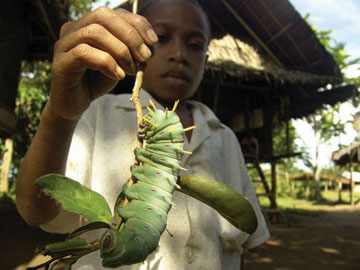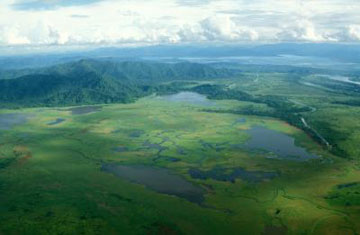Lowland rainforest less diverse than previously thought
Lowland rainforest less diverse than previously thought
mongabay.com
August 9, 2007
0809large_caterpillar
While rainforests are the world’s libraries of biodiversity, species richness may be more evenly distributed in some forests than in others, reports an extensive new study by an international team of entomologists and botanists. The work, published in the current issue of the journal Nature, has important implications for forest management and conservation strategies.
To date, most research has focused on biodiversity “hot spots,” usually in areas “where steep gradients in elevation, temperature, rainfall and other environmental factors boost diversity by creating diverse habitats within a short distance,” explains a news release from the Smithsonian, scientists from which participated in the study. “Such change in a region’s species makeup between sites is called beta diversity: some rainforests have steep environmental gradients and high beta diversity.”
While such hotspots contain a significant proportion of the world’s species, much of the world’s remaining rainforests consists of lowland forests in New Guinea, Borneo and the Congo and Amazon Basins. Researchers have long debated whether such lowland areas also harbor high beta diversity. Now the have the answer.
Collecting and comparing insects and plants from eight study sites across 75,000 square kilometers of contiguous forest, researchers found that low beta diversity, suggesting that “species tend to be widespread and the biological communities change very little even across large distances.”

A Papuan child holding a large caterpillar. Credit: the Smithsonian Institution
|
The findings came as a surprise since many species lead sedentary lives and are generally believed to have a high degree of specialization in terms of the plants on which they feed.
“Some spend their entire lives on a single plant, but they’ve got wings. They may not want to fly, but they can if they need to,” said Smithsonian scientist Scott Miller, an author of the Nature paper.
Further, notes the Smithsonian, insects “showed limited specialization in the plant species they feed upon, in contrast to the common assumption that tropical species tend to be highly specialized.”
The researchers found that among insects studied — fruit flies, beetles, and butterflies — sites separated by as much as 500 kilometers shared more than half of their species

An undisturbed, virgin rainforest where the research team worked. Credit: Jiri Hulcr, Michigan State University
|
“What we found was that the composition of the community of beetles does not change with distance as long as the environment is stable,” Cognato said. “Even communities hundreds of miles apart are the same. And if there are differences, they seem to be random and not caused by any environmental change.”
According to the Smithsonian, the research suggests that lowland forests may be less biodiverse in terms of total species richness than previously believed. Their relative homogeneity means that conservation strategies that focus on single large tracts of lowland forest may be a better option than many small reserves, which are typically more affected by fragmentation.
“Because diversity doesn’t necessarily increase with distance, but animals in small reserves tend to go extinct, you should plan for one large area instead of having a lot of small and distant areas to manage and conserve,” said Michigan State University graduate student Jiri Hulcr, who also participated in the study.
“There are some philosophical questions that our data should be useful to address,” added Miller. “If you can preserve 10,000 hectares of forest, is it better to preserve it as 10 small 1,000 hectare plots or one large 10,000 hectare plot?”
“Our data from the New Guinea lowland forest suggests that bigger is better,” Miller continued. “In this kind of relatively uniform habitat, you’re not losing a lot of beta diversity that would have to be represented by several smaller sites. But the opposite might apply on elevation or climate gradient.”
The scientists say more research is needed before making specific conservation management decisions.
“We haven’t solved the conservation management question by any means,” Miller said, while noting that similar research “needs to be replicated across a large spatial scale in the Amazon Basin and the Congo Basin to see if the low beta diversity pattern holds.”
This article is based on a news release from the Smithsonian and uses quotes from a Michigan State University press release.














